Improper waste disposal, a colossal loss to the country
By Dhaneshi Yatawara
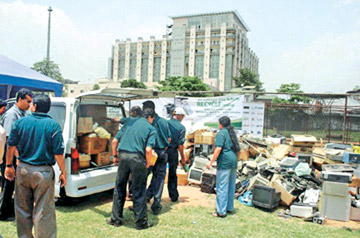 |
| Collecting
e-waste |
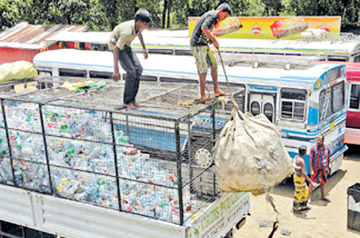 |
| |
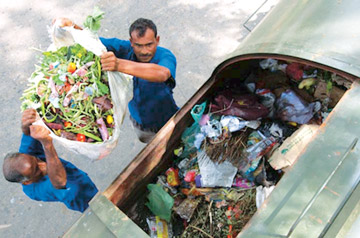 |
| |
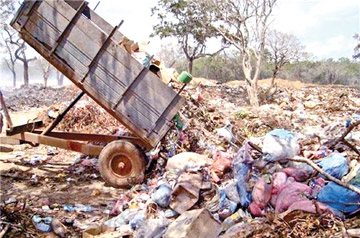 |
| Waste disposal |
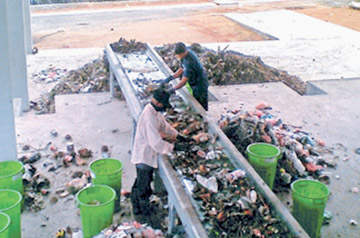 |
| A recycling
plant |
Sri Lankans contributed to collect 15 million lunch sheets a day
according to a research done jointly by the University of Kelaniya and
the Central Environment Authority in 2012.
Researchers revealed that 20 million shopping bags are dumped each
day while 20 million
yoghurt cups and one million sachet packets are dumped per month.
Every time some one goes shopping he/she brings home several polythene
bags which are not recycled or reused. Around six to seven shopping bags
are discarded each day by a family. That number has to be multiplied
with approximately 4.2 million families in the country.
Garbage is a persistent problem as it is not disposed properly. Solid
waste managemnet is a vital factor to mitigate the adverse effects of
environmental pollution.
Public places are worst affected. A popular place like Sri Pada is
known to collect two and half truck loads of waste per day. The quantity
of waste increases according ot the number of visitors according to the
Central Environment Authority.
In controlling the garbaeg menace the authorities have taken two
important steps such as post consumer plastic management and solid waste
management.
Post Consumer Plastic Waste (PCPW) has created problems in all
communities in a major way. Though numerous steps have been taken to
address the problem it still remains unsolved. due to the improper
disposal of garbage which causes enormous damage to the environment.
Imports
Sri Lanka imports annually a considerable amount of plastic raw
materials
and finished products and a major portion of them ends up as Post
Consumer Plastic Waste causing severe environmental problems. The
Project was initially funded by 1 percent Cess imposed on imports of all
plastic raw materials and finished goods and thereafter it was increased
up to 10 percent on reducing prices of virgin plastics due to a fuel
price drop in 2009.
Under the National Post Consumer Plastic Waste Management Project,
the Central Environment Authority over the years has come up with
different programs to address the problem. The National Post Consumer
Plastics Waste Management Project will focus on three main programs such
as development of regional plastic waste collection system, development
of plastic recycling network and awareness and promotional campaign.
The project, implemented in mid 2007, also focus on the behavioural
change among consumers to ensure proper disposal of plastic waste and to
put in place the necessary logistics to enable the collection and
recycling.
Contamination
A considerable portion of the post consumer plastic consist of lunch
sheets, grocery bags and carrier bags.In recycling these plastic and
polythene the biggest problem is its contamination with dirt - in the
case of lunch sheets those are thrown away with left over food . These
contaminations need to be removed, thus these post consumer plastic
waste was washed before recycling.
To expedite this process the CEA established a new system to wash the
waste in recycler plants.
The washing plants are set up in Western province - one for each
district.
Heavy polythene is easily accepted by the recyclers as those are easy
to recycle and less contamination. Plastics are especially troublesome,
as different types of plastic require different processing to be
reformulated and re-used as raw material. Recycling e lunch sheets,
shopping bags is not a an easy task.
Solid waste
Garbage is indeed a problem that has spread far and wide and is
affecting people from all walks of life. Garbage not only is a eye-sore
but also helpd breed mosquitoes and attract flies..
Municipal Councils spend millions of rupees a day on garbage
collection.
This garbage mostly include discarded vegetable and fruit
particlesand solid waste.
The shortage of dumping sites for the local authorities has worsened
the situation as open dumping sites create huge environmental and health
issues Through the CEA the Local Authorities were given the technical
know-how and the funding to tackle this issue and made use of this
municipal waste as a resource based on the limited space and facilities
they have.
On a rough estimation, in the western province alone, 60 to 70
percent of the waste are perishable waste and another 15 to 20 percent
is recyclable waste. Therefor, waste can be used as a resource. The
composting of perishable waste is also implemented at different level at
houses and and local authority level.
While using different techniques to manage, recycle solid and post
consumer plastic waste the authorities need to set up a technique to
change the behavioural patterns of the humans if we wish to have a clean
environment.
Identifying plastics
Numbers ranging from one to seven surrounded by a triangle of arrows
was
designed by the Society of the Plastics Industry (SPI) in 1988 to
allow consumers and recyclers to differentiate types of plastics while
providing a uniform coding system for manufacturers.
Easy Plastics to Recycle - number 1
The easiest and most common plastics to recycle are made of
polyethylene terephthalate (PETE) and are assigned the number 1. Once it
has been processed by a recycling facility, PETE can become fiberfill
for winter coats, sleeping bags and life jackets. It can also be used to
make bean bags, rope, car bumpers, tennis balls, combs, cassette tapes,
sails for boats, furniture and plastic bottles.
Found in: soft drink, water and beer bottles; mouthwash bottles;
peanut butter containers; salad dressing and vegetable oil containers;
ovenable food trays.
Number 2 -
Number 2 is reserved for high-density polyethylene (HDPE) plastics.
These include heavier containers. These are widely accepted at recycling
centres.
HDPE is a versatile plastic with many uses, especially for packaging.
It carries low risk of leaching and is readily recyclable into many
goods.
Found in: milk jugs, juice bottles; bleach, detergent and household
cleaner
bottles; shampoo bottles; some trash and shopping bags; motor oil
bottles; butter and yoghurt tubs; cereal box liners.
Number 2 is often recycled into toys, piping, plastic lumber and
rope.
Plastics Less Commonly Recycled - Number 3 *
This includes Polyvinyl chloride (PVC), commonly used in plastic
pipes, shower curtains, medical tubing, vinyl dashboards, and even some
baby bottle nipples. These are rarely recycled; accepted by some plastic
lumber makers. Once recycled can be conerted in to decks, paneling,
mudflaps, roadway gutters, flooring, cables, speed bumps, mats.
PVC is tough and weathers well, so it is commonly used for piping,
siding
and similar applications. PVC contains chlorine, so its manufacture
can release highly dangerous dioxins. When cooking with PVC, don't let
the plastic touch food. Also never burn PVC, because it releases toxins.
Found in: Window cleaner and detergent bottles, shampoo bottles,
cooking oil bottles, clear food packaging, wire jacketing, medical
equipment, sliding, windows, piping
Number 4 - The low density polythenes (low density polyethylene - LDPE) Number 4s include wrapping films, grocery and sandwich bags, and
other containers made of low-density polyethylene. Once recycled can be
used in trash can liners and cans, compost bins, shipping envelopes,
paneling, lumber, landscaping ties, floor tile. LDPE is a flexible
plastic with many applications.
Found in: Squeezable bottles; bread, frozen food, dry cleaning and
shopping bags; tote bags; clothing; furniture; carpet .
Number 5 - PP or Polypropylene *
Polypropylene has a high melting point, and so is often chosen for
containers that must accept hot liquid. It is gradually becoming more
accepted by recyclers. When recycled can be used in signal lights,
battery cables, brooms, brushes, auto battery cases, ice scrapers,
landscape borders, bicycle racks, rakes, bins, pallets, trays.
Found in: Some yoghurt containers, syrup bottles, ketchup bottles,
caps, straws, medicine bottles
*6) Number 6 Plastics - polystyrene (Styrofoam) *
The Number 6 was long on environmentalists’ hit lists for dispersing
widely across the landscape, and for being notoriously difficult to
recycle.
Polystyrene can be made into rigid or foam products - in the latter
case it is popularly known as the trademark Styrofoam. Evidence suggests
polystyrene can leach potential toxins into foods. Most places still
don't accept it, though it is gradually gaining traction.
Found in: Disposable plates and cups, meat trays, egg cartons,
carry-out containers, aspirin bottles, compact disc cases
Recycled into: Insulation, light switch plates, egg cartons, vents,
rulers, foam packing, carry-out containers
Number 7 Plastics - Hardest Plastics
Are crafted from various combinations of the above mentioned plastics
or from unique plastic formulations not commonly used. A wide variety of
plastic resins that don't fit into the previous categories are lumped
into number 7.
The controversial Polycarbonate falls in to number 7. A few are even
made from plants (polyactide) and can be turned in to compost.
When recycled can be used in manufacturing plastic lumber and
custom-made products.
Found in: three- and five-gallon water bottles, ‘bullet-proof’
materials, sunglasses, DVDs, iPod and computer cases, signs and
displays, certain food containers, nylon. |

